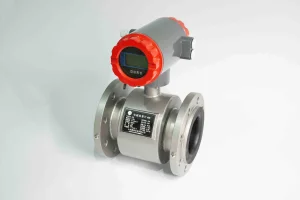
電磁流量計、またはEMFは、閉じたパイプを通じてどのくらいの液体が移動しているかをチェックするファンシーな装置です。水のような電気を運ぶ液体で動作します。電磁流量計はファラデイ法則を用いて動作します。この法則は、電気を導く液体が磁場を通じて流れるとき、微小な電荷または電圧を生み出すと言っています。
電磁流量計にはセンサーとコンバータという2つの主要な部分があります.センサーは液体の速度を見つける。変換器はその情報を使える数字に変換します。
シェルは特別な金属で作られた強いカバーです。すべての部品を内部で安全に保つ。また、物事を混乱させる可能性のある外部信号をブロックします。メーターの部品のための堅固なランチボックスのように考えてください。
これは液体が流れる管です。それは磁石と混乱しないステンレス鋼やガラスファイバーのような材料で作られています。これにより、液体は水のスライドのようにスムーズに移動します。
電極はパイプ内に座っている小さな部分です。移動する液体によって作られる電荷を捕まえるように設定されています。パイプの内部に平らにして、流れを阻止しないようにしなければなりません。小さなセンサーが液体から信号を捕捉するようなものです。
変換器は電極から信号を受け取ります。液体がどれだけ速く流れるかを示す数字のような情報に変える。この情報を画面または制御システムに送ることができます。結果を示す計算機のようなものです。
電磁流量計は 場所のトンで使用 それは非常に正確で便利なからです。以下はいくつかの例です。
水処理下水のような汚れた水を測定し、液体の変化に混乱しません。水システムを清潔に保つのに最適です。
工場石油、化学品、鋼鉄などのものを作る液体を制御するのに役立ちます。すべてがスムーズに動いています。
農場作物を灌溉するために使用される水をチェックします。農家が適切な量を使うのに役立ちます。
発電所: 機械を冷却するために水を使用します。問題を迅速に発見し、両方向の流れを測定することができます。
ファラデイの法則は 電磁流量計作業電気を運ぶ液体が磁場を通じて移動すると、小さな電圧を作ると言われています。この電圧はいくつかのものに依存します:
磁場の強さ(B)
液体の動き速度(V)
パイプの幅(D)
電圧(E)は次の式に従います。 E = K × B × V × Dこれはメーターが液体の速度を見つけるのを助けます。おもちゃのボートが流れにどれくらい速く動くかを測るようなものです。
メーターの内部では、コイルはパイプを通じて磁場を作ります。液体が通過すると、このフィールドを切断します。これは電圧を生み出します。パイプの側面の電極はこの電圧を受け取ります。信号を捕まえるために正しく置かれています。変換器はその後、この電圧を使用して流れを計算します。それは、液体からの信号を捕まえるようなものです。
電磁流量計が適切に機能するために,測定された液体は電気伝導性である必要があります.流体は最低伝導度最小値はセンチメートルあたり5マイクロシエメン(μS/cm)である必要があります。伝導率がこのレベルを下回ると,生成された信号は正確な測定に弱すぎます.

電磁流量計 電気を導く液体を測定するのに素晴らしいです。非常に正確で簡単にケアできます。しかし、彼らには限界もあります。いいと難しい部分を見てみましょう。
超正確: これらのメーターはスポットオンの読み取りを与えます。流れ速度を直線で測定するので、液体の厚さの変化は混乱しません。
低保守:動く部品がない場合、すぐに磨けません。つまり、作業時間が少なく、作業時間が長くなります。
多くの液体で動作: 彼らは特別なライニングで化学物質のような堅い液体を処理できます。両方向の流れを測定します。
非伝導性液体を測定できない石油やガスのようなもので動作しません、なぜなら電気を運ぶことはありません。
バブルトラブル大きな空気泡は読み取りを混乱させることができます。
熱限界: 一部のライニングは超熱液体を処理できません。
チェンシュオ これらの問題を解決するメーターを作ります。多くの場所でうまく機能する厳しいデザインを提供しています。
電磁流量計は、電気を運ぶ液体を測定するためにファラデイ法則を使用します。パイプスペースは少なく必要ですが、伝導性物質のみで動作します。超音波計は音波を使用します。非伝導性の液体でさえ どんな液体でも測定できますが より多くの設定が必要です
電磁流量計には,少なくとも5μS/cmの伝導性を持つ液体が必要です.液体は磁場を通って移動し、電圧を作ります。この電圧は、どれだけ速く動いているかを示しています。オイルやガスのような非伝導性液体は、電圧を作らないため機能しません。
超音波メーター 音波を液体を通じて送る。波が移動するのにかかる時間は、流れ速度を示します。それらは水や油のようなあらゆる液体で働くことができます。それは、部屋を越えて叫び、エコを聞くのにどれくらい時間がかかるかをタイミングするようなものです。
電磁流量計は設置が容易です。パイプの幅の約5倍の短いまっすぐなパイプだけが必要です。流れを妨げるものはないため、圧力下降を引き起こさない。しかし、大きな空気泡は問題を引き起こす可能性があります。
水処理施設や化学加工プラントなどのアプリケーションで導電流体を測定する際に電磁流量計を選択します.これらのデバイスは,例外的な測定精度を提供し,簡単な操作を提供します.
ChenShuoは最高の電磁流量計を作ります。そのメーターには、パイプの幅の約5倍の短い直線パイプが必要です。これにより、システムに簡単に入れることができます。彼らは圧力下降を引き起こさず、液体がどれほど厚いか熱いかに関わらず正確に保持します。彼らの彼らの彼らの彼らの彼らの彼らの彼らの彼ら彼らの圧力は外の圧圧圧圧音をブロックするために超強いです。電極はフローを阻止するのを避けるために平らに置かれています。それらは前方の流れ,逆の流れ,即時の流れを別々に表示する内蔵計算機を持っています.セルフチェックにより、スムーズに動くことができます。まるで自分自身をチェックするスマートなおもちゃのようです。
チェンシュオメーターは多くの場所で大きく働く:
水処理下水の厚さに関係なく、正確に測定します。
発電所: 彼らは機械をよく動かすために冷却水を見ています。
化学工場: 厳しい材料は壊れることなく厳しい化学物質を処理します。
農場資源を節約するために作物の水を測定するのに役立ちます。
ChenShuoは流量計のための素晴らしい選択です。彼らは超信頼性の高い高品質のツールを作ります。そのメーターには流れを両方向に測定するようなクールな特徴があります。彼らはまた、あなたを助けるために大きなサポートを提供します。ChenShuoを選ぶことは、あなたのニーズに適した堅く、スマートなツールを得ることを意味します。まるで学校用のバックパックを選ぶようなものです。
Q1:電磁流量計はオイルを測定できますか。
A: いいえ、電気を運ぶ液体が必要です。
Q2:どの産業は超音波流量計を使用しますか。
A: 石油やガスにとっては最適です。
Q3: どのように電磁流量計から正確な読み取りを得ますか。
A: 空気泡を外に保ち、液体が十分な伝導性を持っていることを確認します。